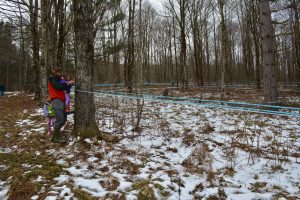The Orange is going green: Sustainability at Syracuse University
Orange going green: Sustainability at SU

At the Leaders Summit on Climate in April, President Joe Biden pledged that the United States would reduce emissions by 50% from the country’s 2005 levels by the year 2030. Though mostly symbolic (rather than legislative,) this goal has set the wheels in motion for his administration’s efforts to fight climate change.
Experts have been pressing government leaders for years to prioritize climate change. A 2018 Intergovernmental Panel on Climate Change report suggested that if climate change is not adequately addressed within the next 12 years, there will be irreversible damage to the planet’s ecosystems.
Climate change is a global issue, but changes made at institutional, community and individual levels can have a significant impact long term. Part of the equation is sustainability, which has been a key initiative at Syracuse University. Here’s what’s been done so far and some propositions being considered to make the Orange more green:
What is sustainability? | Is SU sustainable? | What is the plan for the future?
What needs to happen? | What can you do to be more sustainable?
What is sustainability?
Sustainability is a broad term, and there are different definitions for the concept. According to Merriam-Webster Dictionary sustainability is “using a resource so that the resource is not depleted or permanently damaged.” So how do we avoid depleting resources? One way is to use resources that are safe for the environment and ones that can be renewed, or find ways to put the resources back into the environment to be re-used.
Geography and the environment associate professor at SU, Robert Wilson, offered a similar definition for sustainability.
“For me, it would be trying to conserve resources for the widest possible group in the most equitable way for the longest time,” Wilson said. “So [it’s] trying to both conserve resources but also the systems upon which we depend to survive.”
Think about when you drive a car. Every time you drive, fuel is burned and turned into a gas that then enters the atmosphere and can never be used again; thus gas is not sustainable. But if you use electricity made from wind or solar power to run your car, then you are using a sustainable energy source. Whereas gas and oil are finite, wind and solar power are not. The same concept applies to food, water, buildings and nearly everything that we rely on to live.
Is SU sustainable?
There are a number of ways to evaluate an institution’s current level of sustainability. SU is a member of the Sustainability Tracking, Assessment & Rating System (STARS), a system used to rate the sustainability of higher education institutions across the country. Scores are assigned for various categories, and ultimately a score on a 100-point scale is given which corresponds to a certain recognition level from bronze to platinum. SU earned a silver rating with a 53.65 score in the most recent evaluation in 2018, leaving room for improvement.
Currently, SU employs a number of sustainability practices, however, the university still implements many practices that are unsustainable. For example, most of the north campus buildings’ heating and cooling systems are powered by a plant that uses natural gas fuel sources. South campus buildings are also powered by these plants, but the south campus apartments’ heating and cooling is run by electricity, some of it coming from solar panels and wind energy.
Wilson said systems that include natural gas pipelines often leak methane, a powerful accelerant of global warming, into the atmosphere.
“Methane is a very potent greenhouse gas, so if you think of CO2 like a blanket in the atmosphere trapping heat, methane is like a big down comforter,” Wilson said. “If we’re going to do something about climate change, we have to do something about these fugitive methane emissions.”
Another major contributor to climate change is consumption. Waste materials reach landfills or are burned, releasing harmful gases into the atmosphere. A 2009 Environmental Protection Agency report concluded that up to 42% of the U.S. greenhouse gas emissions stem from energy used to produce and get rid of the food and goods we consume on a daily basis.
At SU, a lot of the waste comes from dining halls and waste management systems. According to the University’s STARS report, SU generated 6,360 tons of waste between July 1, 2014, and June 30, 2015, a marked increase from the baseline year of the same period between 2010 and 2011 which saw SU generate 5,058 tons of waste.
Though it would be a large financial burden to quickly transition to a fully sustainable campus, SU is investing some money into the purchase of renewable energy for use on campus and has started to place measures to reduce emissions and reduce waste.
The University has created
- food pantries and gardens on campus and
- engaged in activities to protect bee populations.
- A small composting operation is also run on campus.
But given the limited amount of time left to fight climate change, SU’s plans may not be moving fast enough.
What is the plan for the future?
SU drafted a Climate Action Plan in 2009 and continues to work to meet the goals outlined in the plan. The University’s plan is to become carbon neutral by the year 2040, meaning they will not emit any greenhouse gases into the atmosphere. The plan also outlines the University’s desire to commit more resources to sustainability education, research and implementation of emerging technologies.
Members of SU’s Student Association recently unveiled their Green New Deal, a proposal that SU enhance sustainability efforts beyond what is laid out in the 12-year-old climate action plan. SA’s requests included:
- Achieving carbon neutrality by 2026
- Enhancing dining sustainability
- Eliminating single-use plastics
- Increasing composting and recycling
- Creating a climate corps
- Increasing transparency on matters of sustainability
SA Sustainability Committee director, Fiona Thayer, said SA’s demands may be more appealing now because of President Biden’s rallying cry for emissions reductions.
“I think that with Biden as president and the goals that he’s set with reducing emissions, the University is going to be much more likely to commit to similar goals because he’s paved the way and universities and institutions have to follow,” Thayer said.
As the director, Thayer is tasked with spearheading SA’s sustainability promotion efforts, working with community organizations and administration, and raising awareness for sustainability on campus.
Despite SA’s enthusiasm and Biden’s pledge on the world stage, SU sustainability coordinator Melissa Caldwell said the university is continuing on its current course of action.
“Our goal is to become carbon neutral by reducing our carbon emissions as much as possible, through LEED buildings, LED lighting, retrofitting, energy conservation and education and awareness,” Caldwell said in a written statement. “In the end, we will still have a few carbon emissions left and we will purchase Renewable Energy certificates to mitigate it.”
Wilson suggested sustainability efforts need to be accelerated with the clock ticking on combating climate change.
“Climate change is already affecting Central New York and will continue to in the coming decades,” Wilson said.“We’ve lost precious decades dithering and not taking the necessary actions to deal with the threat. There’s much we need to do to ensure a sustainable, equitable future for all people and not much time to do it.”
What needs to happen?
Addressing climate change is a monumental task, and it will change every aspect of the current economic, political and social systems for the remainder of this century. Although it might seem daunting, some things must happen in order to take strides towards a fully sustainable future.
For inspiration, Syracuse can look to American University in Washington D.C., where in 2018, it became the first university in the country to achieve net 0 carbon emissions. By switching to renewable energy sources and using what is known as “carbon offset” to balance any emissions created on their campus, AU was able to achieve net 0 carbon emissions two years ahead of its goal of 2020. Though AU’s student population is roughly half the size of SU’s, reaching their net goal of 0, proved that it’s possible for academic institutions to drastically reduce emissions.
In addition to emissions, SU must focus on reducing waste. Neighboring SUNY-ESF has implemented some waste reduction measures in the last few years that have proven to be beneficial in reducing trash on campus.
ESF’s sustainable facilities manager, Sue Fassler, oversaw a 2019 audit of campus trash and recycling bins. Her team created new solutions for better composting and waste management on campus, such as redesigning trash and recycling bins around the ESF and adding in an extensive composting system. The results after less than 2 years have shown promise. ESF’s trash output has reduced 34% by weight and the recycling rate has increased 46%.
“We’re seeing amazing improvements just from changing our bins and adding compost,” Fassler said. “There has been so much improvement that their trash collection has been reduced from five days a week to three.”

Currently, SU does not have campus-wide composting systems, and according to Alyssa Quintero, the outgoing SA Sustainability Committee director, the administration was resistant to adding in compost systems during her tenure.
“The Board of Trustees is unwilling as well as faculty,” Quintero said. “The director of facilities is unwilling to buy compostable stuff. Somewhere like ESF with much fewer resources than us is so capable. They have composting bins and we haven’t even tried it.”
Caldwell acknowledged composting is an issue for students living in SU’s residence halls but the pandemic has curtailed efforts.
“At this time with COVID-19, there was not a way to add it into the residence halls, but all the dining centers have compost bins for the students and we have a robust compost system on South Campus at our office that all students on or off campus can partake in,” said Caldwell, adding that an overhaul of recycling and trash bins to better distinguish them can be expected by September.
Another component of waste is food waste, which on college campuses comes mostly from dining halls. The student-led Food Recovery Network (FRN) at SU and ESF chapter has recovered over 100,000 pounds of food and redistributed it to local food pantries and organizations that then donate it to people in the community facing food insecurity.
FRN member, Theresa Ferrigno, said she finds personal satisfaction in doing her part to help the group.
“I love doing it, but why wasn’t that something that was built into the structure of the dining hall system?” Ferrigno said. “Nobody thought about the food that was getting thrown away, instead of thinking about what you can do with it.”
The COVID-19 pandemic has curtailed sustainability efforts in dining halls as well.
COVID protocols and public health measures required reusable containers and utensils to be replaced by single-use plastics that ultimately are thrown away.
While an end to the pandemic may allow smaller measures to be restored, Wilson said SU needs to play a leading role in educating students, faculty and the community about climate change.
“I think what the institution can do, through the teaching that we do and the people that we bring to campus to speak, is to recognize that to address climate change it’s going to require large structural changes to our economy and those changes are going to play out for decades,” Wilson said.
What can you do to be more sustainable?
Institutions like SU and corporations need to take the lead, but Thayer said individuals can be part of the solution, too.
“I’m a firm believer that community change on smaller levels is where the real action starts,” Thayer said. “Individual action absolutely matters, once you take that individual action and bring it into your own community and try to make changes even if they seem small they’re much bigger than people think.”
Thayer recommended a few ways that anyone could be more sustainable:
- Try to be conscious of your consumption habits
- Consume fewer animal products
- Conserve energy at home
- Save water by taking shorter showers.
Fassler also recommended composting, avoiding products with unnecessary packaging, and eating locally sourced foods, like from the Syracuse Cooperative Market on Kensington Street.
Caldwell said community involvement and volunteering are great ways to make an impact through campus food pantries, gardens and composting operations.
“We also have two student groups, a garden group and Bee Campus USA student group that all our students can join,” she said.
In addition to lifestyle changes, activism is required to push change at the institutional level. Fassler said that if students can push for sustainability in the same way students protested racial injustice at the #NotAgainSU protests, then changes could occur.
“There was a sustained student presence and a sustained loud student voice demanding action,” she said. “They came with a solution, they came with a list of demands.”








